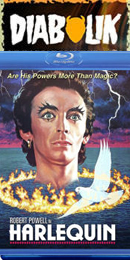
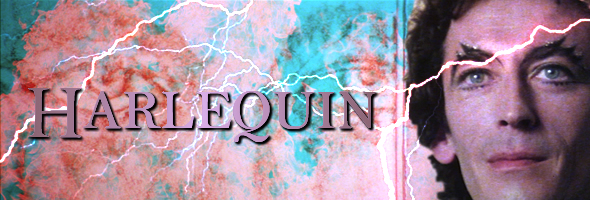
Color, 1980, 95 mins. 45 secs.
Directed by Simon Wincer
Starring Robert Powell, David Hemmings, Carmen Duncan, Broderick Crawford, Gus Mercurio, Mark Spain
Indicator (UHD & Blu-ray) (US/UK R0 4K/HD), Scorpion Releasing (Blu-ray) (US R0 HD/NTSC), Synapse Films, Elite Entertainment (DVD) (US R0 NTSC), Umbrella (Australia R0 PAL), Prism (UK R0 PAL), Marketing-Film (Germany R2 PAL) / WS (2.35:1) (16:9)
If you want to see a  film that would drive a modern movie marketing team into hysterics,
film that would drive a modern movie marketing team into hysterics, 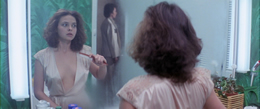 look no further than Harlequin, a bizarre and highly memorable Australian thriller-fantasy-sci-fi-drama-horror oddity unleashed under the title Dark Forces in America and on numerous home video formats. A significant step up for director Simon Wincer after his oddball debut film, The Day After Halloween (aka Snapshot), this was enough to catapult him to the big time in his native country, where he went on to helm The Lighthorsemen and Phar Lap. Of course, he also became a highly accomplished western director thanks to Lonesome Dove and the still underrated Quigley Down Under, though he hasn't reach those heights again in quite a while.
look no further than Harlequin, a bizarre and highly memorable Australian thriller-fantasy-sci-fi-drama-horror oddity unleashed under the title Dark Forces in America and on numerous home video formats. A significant step up for director Simon Wincer after his oddball debut film, The Day After Halloween (aka Snapshot), this was enough to catapult him to the big time in his native country, where he went on to helm The Lighthorsemen and Phar Lap. Of course, he also became a highly accomplished western director thanks to Lonesome Dove and the still underrated Quigley Down Under, though he hasn't reach those heights again in quite a while.
What we have here is essentially a modernized version of the story of Rasputin, the infamous, nearly unkillable Russian mystic whose mesmeric powers held sway over the czar's family in the early 1900s. In this case the mysterious character at the center of the story is Gregory Wolfe (Powell), who steps into the life of rising politician Nick Rast (Deep Red's Hemmings) and offers to cure his cancer-stricken son, Alex (Spain). Gregory exercises an increasing amount of control over the Rast family (try spelling their name backwards), including Nick's wife, Sandra (Escape 2000's Duncan), and engages in a battle of wits with an American bigwig (Crawford) trying to push Nick up the political ladder. While many seem to think the spooky newcomer could be a charlatan, Nick soon learns that there's quite a bit more going on than meets the eye.
Part of the golden 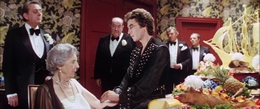 era of Australian genre films alongside other offerings like Thirst, Harlequin may be the most surreal of them all, particularly in the climax involving a fantastic disco harlequin outfit and indoor lightning bolts. Also bear in mind that the film's PG rating was given at a time when you could still get away with some flashes of nudity and blood, which this film manages to slip by where you least expect it. Of course, it's really Robert Powell's show all the way, and the actor (who was still familiar to many for playing Jesus of Nazareth on TV) manages to deliver a suitably gripping performance thanks to his piercing eyes and peculiar line delivery. There's also a fine albeit quirky music score by Brian May, who was apparently scoring every single Australian film in production at the time.
era of Australian genre films alongside other offerings like Thirst, Harlequin may be the most surreal of them all, particularly in the climax involving a fantastic disco harlequin outfit and indoor lightning bolts. Also bear in mind that the film's PG rating was given at a time when you could still get away with some flashes of nudity and blood, which this film manages to slip by where you least expect it. Of course, it's really Robert Powell's show all the way, and the actor (who was still familiar to many for playing Jesus of Nazareth on TV) manages to deliver a suitably gripping performance thanks to his piercing eyes and peculiar line delivery. There's also a fine albeit quirky music score by Brian May, who was apparently scoring every single Australian film in production at the time.
A home video staple since its VHS incarnation from Media, Harlequin bowed on DVD from Elite Entertainment in 2004 as Dark Forces, oddly never appearing in either of their Aussie horror boxed sets. It featured a solid transfer for the time, retaining the original scope framing (which is absolutely crucial to the film), and tossed in some good extras including an isolated score track, alternate Spanish and French dub tracks, and a good audio commentary with Wincer and producer Anthony I. Ginnane, a familiar fixture by now from numerous chat tracks and video interviews on various Aussie horror DVDs. They cover a wide variety of topics including the Rasputin influence, the presence of Hemmings (who was himself directing Powell in Australia shortly after this), and the sudden surge of new filmmaking blood in the cinematic community at the time. Essentially the same package with a slightly buffed transfer (increasing the bit rate and eliminating some film debris) came from Synapse in 2008 on DVD, with the same transfer 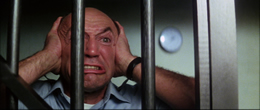 popping up in between in the U.K., Germany, and Australia.
popping up in between in the U.K., Germany, and Australia.
As anyone who has seen the film could probably guess, the leap to HD raised some interesting issues concerning  the look of this film, which is bathed throughout in heavy filters designed to give it a hazy, otherworldly look. Think about some mid-'70s films lensed by Vilmos Zsigmond like Obsession and The Long Goodbye, and you'll get the idea. Exterior scenes in particular are suffused with soft lighting, a look that's fallen completely out of fashion now. Therefore, the 2013 Blu-ray edition from Scorpion copes with these issues about as well as one could expect; it looks like 35mm film, warts and all, and marks the most colorful, clear rendition to date, relatively speaking. Thankfully there hasn't been any digital futzing to remove the grain, which would have been disastrous. Don't go in expecting razor sharp demo material here; it is what it is, and if you're a fan of the film, this is about as close as you'll probably get to the original 35mm appearance in your home. The isolated score and commentary track are ported over here, and new here is a a "trivia facts" video segment with "Katarina the Klown," a.k.a. label hostess Katarina Leigh Waters. The sight of her cavorting in a really scary harlequin outfit will either tickle or terrify you, and be sure to read the closing credits for a disclaimer you definitely won't see anywhere else. The original trailer is also included along with previews for Tower of Evil, Grizzly, and Death Ship.
the look of this film, which is bathed throughout in heavy filters designed to give it a hazy, otherworldly look. Think about some mid-'70s films lensed by Vilmos Zsigmond like Obsession and The Long Goodbye, and you'll get the idea. Exterior scenes in particular are suffused with soft lighting, a look that's fallen completely out of fashion now. Therefore, the 2013 Blu-ray edition from Scorpion copes with these issues about as well as one could expect; it looks like 35mm film, warts and all, and marks the most colorful, clear rendition to date, relatively speaking. Thankfully there hasn't been any digital futzing to remove the grain, which would have been disastrous. Don't go in expecting razor sharp demo material here; it is what it is, and if you're a fan of the film, this is about as close as you'll probably get to the original 35mm appearance in your home. The isolated score and commentary track are ported over here, and new here is a a "trivia facts" video segment with "Katarina the Klown," a.k.a. label hostess Katarina Leigh Waters. The sight of her cavorting in a really scary harlequin outfit will either tickle or terrify you, and be sure to read the closing credits for a disclaimer you definitely won't see anywhere else. The original trailer is also included along with previews for Tower of Evil, Grizzly, and Death Ship.
In 2025, Indicator upgraded the film to UHD and Blu-ray as separate limited edition format releases in both the U.S. and U.K. featuring a new 4K HDR restoration with the UHD being preferable given the HDR10-compatible Dolby Vision grading which brings more punch  out of the colors than you'd probably expect. The Blu-ray looks excellent as well though; this will never be a particularly crisp feature, but it's likely there's no way it could look better than the fresh and impressive presentation here. The DTS-HD MA 2.0 English mono track sounds very good and comes with optional English subtitles; the 2004 commentary by Wincer and Ginnane is ported
out of the colors than you'd probably expect. The Blu-ray looks excellent as well though; this will never be a particularly crisp feature, but it's likely there's no way it could look better than the fresh and impressive presentation here. The DTS-HD MA 2.0 English mono track sounds very good and comes with optional English subtitles; the 2004 commentary by Wincer and Ginnane is ported  over, with the isolated music score (in nice LPCM stereo) as a third audio option. Next as with other significant Aussie cult titles you get a batch of outtake footage from interviews conducted for Mark Hartley's Not Quite Hollywood featuring Wincer (20m26s), Ginnane (21m23s), writer Everett De Roche (3m1s), and actor Gus Mercurio (5m36s), mixing a grab bag of production anecdotes (including a funny bit about Crawford's pants) and a portrait of the local film industry around the turn of the decade. Then you get a collection of archival interviews including a TV appearance by Hemmings and Powell (6m1s) in 1980 for the Aussie show Clapperboard, De Roche in 2007 for the show The Bazurka Project (5m29s), and extensive 1979 audio of Wincer (75m43s), associate producer Jane Scott (51m51s), and production designer Bernard Hides (34m49s) on the film set interviewed for the magazine Cinema Papers. Next is a perceptive appreciation by Stephen Morgan (15m34s) about the goal to make a less rushed and more polished film than the previous Snapshot, the odd mixture of genres and styles at play, and the mutation of its screenplay including the lessening of its religious elements. Then "Destruction from Down Under: An Ozsploitation Retrospective" (15m33s) features Kim Newman covering the distinct elements and merits of the Australian onslaught of horror, sci-fi, and thriller titles that found a welcome international audience throughout the '70s and '80s from drive-ins to more upscale theaters. Finally you get three trailers (two Aussie, one U.S. as Dark Forces) and an image gallery of promotional material and production photos. The package also comes with an 80-page book featuring a new essay by Julian Upton, excerpts from Ginnane’s unpublished memoirs, and archival interviews with Wincer and Hides.
over, with the isolated music score (in nice LPCM stereo) as a third audio option. Next as with other significant Aussie cult titles you get a batch of outtake footage from interviews conducted for Mark Hartley's Not Quite Hollywood featuring Wincer (20m26s), Ginnane (21m23s), writer Everett De Roche (3m1s), and actor Gus Mercurio (5m36s), mixing a grab bag of production anecdotes (including a funny bit about Crawford's pants) and a portrait of the local film industry around the turn of the decade. Then you get a collection of archival interviews including a TV appearance by Hemmings and Powell (6m1s) in 1980 for the Aussie show Clapperboard, De Roche in 2007 for the show The Bazurka Project (5m29s), and extensive 1979 audio of Wincer (75m43s), associate producer Jane Scott (51m51s), and production designer Bernard Hides (34m49s) on the film set interviewed for the magazine Cinema Papers. Next is a perceptive appreciation by Stephen Morgan (15m34s) about the goal to make a less rushed and more polished film than the previous Snapshot, the odd mixture of genres and styles at play, and the mutation of its screenplay including the lessening of its religious elements. Then "Destruction from Down Under: An Ozsploitation Retrospective" (15m33s) features Kim Newman covering the distinct elements and merits of the Australian onslaught of horror, sci-fi, and thriller titles that found a welcome international audience throughout the '70s and '80s from drive-ins to more upscale theaters. Finally you get three trailers (two Aussie, one U.S. as Dark Forces) and an image gallery of promotional material and production photos. The package also comes with an 80-page book featuring a new essay by Julian Upton, excerpts from Ginnane’s unpublished memoirs, and archival interviews with Wincer and Hides.
INDICATOR (Blu-ray)





SCORPION RELEASING (Blu-ray)





Updated review on April 7, 2025



 film that would drive a modern movie marketing team into hysterics,
film that would drive a modern movie marketing team into hysterics,  look no further than Harlequin, a bizarre and highly memorable Australian thriller-fantasy-sci-fi-drama-horror oddity unleashed under the title Dark Forces in America and on numerous home video formats. A significant step up for director Simon Wincer after his oddball debut film, The Day After Halloween (aka Snapshot), this was enough to catapult him to the big time in his native country, where he went on to helm The Lighthorsemen and Phar Lap. Of course, he also became a highly accomplished western director thanks to Lonesome Dove and the still underrated Quigley Down Under, though he hasn't reach those heights again in quite a while.
look no further than Harlequin, a bizarre and highly memorable Australian thriller-fantasy-sci-fi-drama-horror oddity unleashed under the title Dark Forces in America and on numerous home video formats. A significant step up for director Simon Wincer after his oddball debut film, The Day After Halloween (aka Snapshot), this was enough to catapult him to the big time in his native country, where he went on to helm The Lighthorsemen and Phar Lap. Of course, he also became a highly accomplished western director thanks to Lonesome Dove and the still underrated Quigley Down Under, though he hasn't reach those heights again in quite a while. 
 era of Australian genre films alongside other offerings like Thirst, Harlequin may be the most surreal of them all, particularly in the climax involving a fantastic disco harlequin outfit and indoor lightning bolts. Also bear in mind that the film's PG rating was given at a time when you could still get away with some flashes of nudity and blood, which this film manages to slip by where you least expect it. Of course, it's really Robert Powell's show all the way, and the actor (who was still familiar to many for playing Jesus of Nazareth on TV) manages to deliver a suitably gripping performance thanks to his piercing eyes and peculiar line delivery. There's also a fine albeit quirky music score by Brian May, who was apparently scoring every single Australian film in production at the time.
era of Australian genre films alongside other offerings like Thirst, Harlequin may be the most surreal of them all, particularly in the climax involving a fantastic disco harlequin outfit and indoor lightning bolts. Also bear in mind that the film's PG rating was given at a time when you could still get away with some flashes of nudity and blood, which this film manages to slip by where you least expect it. Of course, it's really Robert Powell's show all the way, and the actor (who was still familiar to many for playing Jesus of Nazareth on TV) manages to deliver a suitably gripping performance thanks to his piercing eyes and peculiar line delivery. There's also a fine albeit quirky music score by Brian May, who was apparently scoring every single Australian film in production at the time.  popping up in between in the U.K., Germany, and Australia.
popping up in between in the U.K., Germany, and Australia.  the look of this film, which is bathed throughout in heavy filters designed to give it a hazy, otherworldly look. Think about some mid-'70s films lensed by Vilmos Zsigmond like Obsession and The Long Goodbye, and you'll get the idea. Exterior scenes in particular are suffused with soft lighting, a look that's fallen completely out of fashion now. Therefore, the 2013 Blu-ray edition from Scorpion copes with these issues about as well as one could expect; it looks like 35mm film, warts and all, and marks the most colorful, clear rendition to date, relatively speaking. Thankfully there hasn't been any digital futzing to remove the grain, which would have been disastrous. Don't go in expecting razor sharp demo material here; it is what it is, and if you're a fan of the film, this is about as close as you'll probably get to the original 35mm appearance in your home. The isolated score and commentary track are ported over here, and new here is a a "trivia facts" video segment with "Katarina the Klown," a.k.a. label hostess Katarina Leigh Waters. The sight of her cavorting in a really scary harlequin outfit will either tickle or terrify you, and be sure to read the closing credits for a disclaimer you definitely won't see anywhere else. The original trailer is also included along with previews for Tower of Evil, Grizzly, and Death Ship.
the look of this film, which is bathed throughout in heavy filters designed to give it a hazy, otherworldly look. Think about some mid-'70s films lensed by Vilmos Zsigmond like Obsession and The Long Goodbye, and you'll get the idea. Exterior scenes in particular are suffused with soft lighting, a look that's fallen completely out of fashion now. Therefore, the 2013 Blu-ray edition from Scorpion copes with these issues about as well as one could expect; it looks like 35mm film, warts and all, and marks the most colorful, clear rendition to date, relatively speaking. Thankfully there hasn't been any digital futzing to remove the grain, which would have been disastrous. Don't go in expecting razor sharp demo material here; it is what it is, and if you're a fan of the film, this is about as close as you'll probably get to the original 35mm appearance in your home. The isolated score and commentary track are ported over here, and new here is a a "trivia facts" video segment with "Katarina the Klown," a.k.a. label hostess Katarina Leigh Waters. The sight of her cavorting in a really scary harlequin outfit will either tickle or terrify you, and be sure to read the closing credits for a disclaimer you definitely won't see anywhere else. The original trailer is also included along with previews for Tower of Evil, Grizzly, and Death Ship. out of the colors than you'd probably expect. The Blu-ray looks excellent as well though; this will never be a particularly crisp feature, but it's likely there's no way it could look better than the fresh and impressive presentation here. The DTS-HD MA 2.0 English mono track sounds very good and comes with optional English subtitles; the 2004 commentary by Wincer and Ginnane is ported
out of the colors than you'd probably expect. The Blu-ray looks excellent as well though; this will never be a particularly crisp feature, but it's likely there's no way it could look better than the fresh and impressive presentation here. The DTS-HD MA 2.0 English mono track sounds very good and comes with optional English subtitles; the 2004 commentary by Wincer and Ginnane is ported  over, with the isolated music score (in nice LPCM stereo) as a third audio option. Next as with other significant Aussie cult titles you get a batch of outtake footage from interviews conducted for Mark Hartley's Not Quite Hollywood featuring Wincer (20m26s), Ginnane (21m23s), writer Everett De Roche (3m1s), and actor Gus Mercurio (5m36s), mixing a grab bag of production anecdotes (including a funny bit about Crawford's pants) and a portrait of the local film industry around the turn of the decade. Then you get a collection of archival interviews including a TV appearance by Hemmings and Powell (6m1s) in 1980 for the Aussie show Clapperboard, De Roche in 2007 for the show The Bazurka Project (5m29s), and extensive 1979 audio of Wincer (75m43s), associate producer Jane Scott (51m51s), and production designer Bernard Hides (34m49s) on the film set interviewed for the magazine Cinema Papers. Next is a perceptive appreciation by Stephen Morgan (15m34s) about the goal to make a less rushed and more polished film than the previous Snapshot, the odd mixture of genres and styles at play, and the mutation of its screenplay including the lessening of its religious elements. Then "Destruction from Down Under: An Ozsploitation Retrospective" (15m33s) features Kim Newman covering the distinct elements and merits of the Australian onslaught of horror, sci-fi, and thriller titles that found a welcome international audience throughout the '70s and '80s from drive-ins to more upscale theaters. Finally you get three trailers (two Aussie, one U.S. as Dark Forces) and an image gallery of promotional material and production photos. The package also comes with an 80-page book featuring a new essay by Julian Upton, excerpts from Ginnane’s unpublished memoirs, and archival interviews with Wincer and Hides.
over, with the isolated music score (in nice LPCM stereo) as a third audio option. Next as with other significant Aussie cult titles you get a batch of outtake footage from interviews conducted for Mark Hartley's Not Quite Hollywood featuring Wincer (20m26s), Ginnane (21m23s), writer Everett De Roche (3m1s), and actor Gus Mercurio (5m36s), mixing a grab bag of production anecdotes (including a funny bit about Crawford's pants) and a portrait of the local film industry around the turn of the decade. Then you get a collection of archival interviews including a TV appearance by Hemmings and Powell (6m1s) in 1980 for the Aussie show Clapperboard, De Roche in 2007 for the show The Bazurka Project (5m29s), and extensive 1979 audio of Wincer (75m43s), associate producer Jane Scott (51m51s), and production designer Bernard Hides (34m49s) on the film set interviewed for the magazine Cinema Papers. Next is a perceptive appreciation by Stephen Morgan (15m34s) about the goal to make a less rushed and more polished film than the previous Snapshot, the odd mixture of genres and styles at play, and the mutation of its screenplay including the lessening of its religious elements. Then "Destruction from Down Under: An Ozsploitation Retrospective" (15m33s) features Kim Newman covering the distinct elements and merits of the Australian onslaught of horror, sci-fi, and thriller titles that found a welcome international audience throughout the '70s and '80s from drive-ins to more upscale theaters. Finally you get three trailers (two Aussie, one U.S. as Dark Forces) and an image gallery of promotional material and production photos. The package also comes with an 80-page book featuring a new essay by Julian Upton, excerpts from Ginnane’s unpublished memoirs, and archival interviews with Wincer and Hides.








